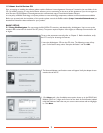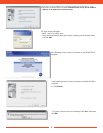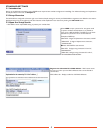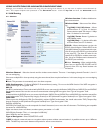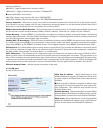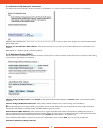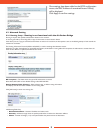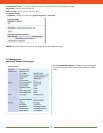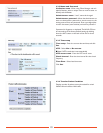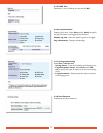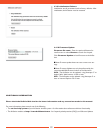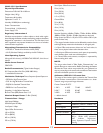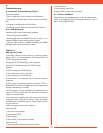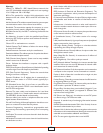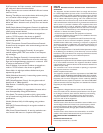
Glossary
10BaseT or 100BaseTx: 802.3 based Ethernet network that
uses UTP (Unshielded twisted pair) cable and a star topology.
10 is 10 Mbps and 100 is 100 Mbps.
802.1x: The standard for wireless LAN authentication used
between an AP and a client. 802.1x with EAP will initiate key
handling.
Ad-Hoc Network: The wireless network based on a peer-to-peer
communications session. Also referred to as AdHoc.
Bandwidth: The transmission capacity of a computer or a com-
munication channel, stated in Megabits per second (Mbps).
BSS (Basic Service Set): An 802.11 networking framework that
includes an .
Bus Mastering: A system in which the specifi ed Input/Output
device (e.g. NIC Card) can perform tasks without the interven-
tion of the CPU.
Client: A PC or workstation on a network.
Default Gateway: The IP Address of either the nearest bridge
or server for the LAN.
Default Parameter: Parameter set by the manufacturer.
Destination Address: The address portion of a packet that identi-
fi es the intended recipient station.
DNS (Domain Name System): System used to map readable
machine names into IP addresses
Driver: Software that interfaces a computer with a specifi c
hardware device.
DSSS (Direct Sequence Spread Spectrum): Method of spreading
a wireless signal into wide frequency bandwidth.
DTE (Data Terminal Equipment): Device that controls data
fl owing to and from a computer.
Dynamic IP Address: An IP address that is automatically as-
signed to a client station in a TCP/IP network, typically by a
DHCP server.
ESS (Extended Service Set): A set of two or more BSSs that
form a single sub-network. ESS-ID is user identifi cation used in
the ESS LAN confi guration.
Ethernet: The most widely used architecture for Local Area
Networks (LANs). It is a shared-media network architecture.
The IEEE 802.3 standard details its functionality.
Ethernet cable: A wire similar to telephone cable that carries
signals between Ethernet devices.
File and Print Sharing: A Microsoft application that allows com-
puters on a network to share fi les and printers.
Firmware: Programming inserted into programmable read-
only memory, thus becoming a permanent part of a computing
device.
Full-Duplex: To transmit on the same channel in both directions
simultaneously.
Half-duplex: To transmit on the same channel in both directions,
one direction at a time.
16
Hub: A device which allows connection of computers and other
devices to form a LAN.
IEEE (Institute of Electrical and Electronics Engineers): The
professional organization which promotes development of
electronics technology.
IP (Internet Protocol) Address: A unique 32-binary-digit number
that identifi es each sender or receiver of information sent in
packets.
Infrastructure: A wireless network or other small network in
which the wireless network devices are made a part of the net-
work through the .
ISP (Internet Service Provider): A company that provides access
to the Internet and other related services.
IV (Initialization Vector): The header section of a message
packet.
LAN (Local Area Network): A group of computers and peripheral
devices connected to share resources.
LED (Light Emitting Diode): The lights on a hardware device
representing the activity through the ports.
MAC (Medium Access Control) Address: A unique number that
distinguishes network cards.
Mbps (Mega Bits Per Second): A measurement of millions of
bits per second.
MHz (MegaHertz): One million cycles per second.
NAT (Network Address Translation): An internet standard that
enables a LAN to use one set of IP addresses for internal traffi c
and a second set for external traffi c.
NIC (Network Interface Card): An expansion card connected to
a computer so the computer can be connected to a network.
Packet: A block of data that is transferred as a single unit, also
called a frame or a block.
Packet Filtering: Discarding unwanted network traffi c based on
its originating address or its type.
Ping (Packet Internet Groper): An Internet utility used to deter-
mine whether a particular IP address is online.
Plug and Play: Hardware that, once installed (“plugged in”), can
immediately be used (“played”), as opposed to hardware that
requires manual confi guration.
PoE (Power over Ethernet): A mechanism to send DC power
to a device using a CAT5 Ethernet cable.
Protocol: A standard way of exchanging information between
computers.
RADIUS (Remote Authentication Dial In User Service): A server
that issues authentication key to clients.
Repeater Hub: A device that collects, strengthens and transmits
information to all connected devices, allowing the network to be
extended to accommodate additional workstations.
RC4: The encryption algorithm that is used in WEP.



